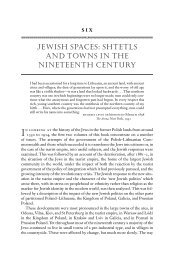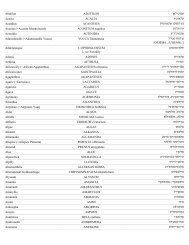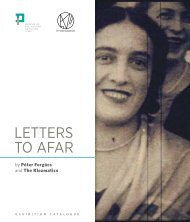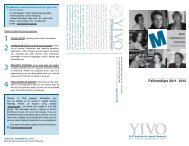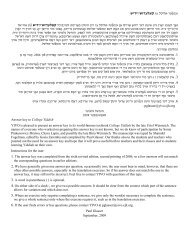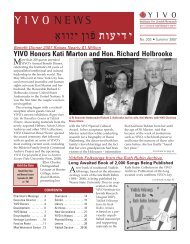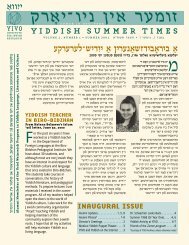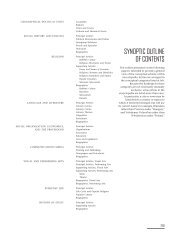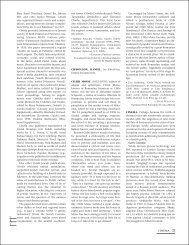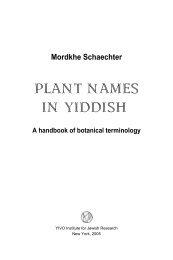geographical–political units - YIVO Institute for Jewish Research
geographical–political units - YIVO Institute for Jewish Research
geographical–political units - YIVO Institute for Jewish Research
You also want an ePaper? Increase the reach of your titles
YUMPU automatically turns print PDFs into web optimized ePapers that Google loves.
Yung-Vilne<br />
Yung-Vilne (Young Vilna) was a dynamic Yiddish literary group of writers, poets,<br />
and artists who came of age creatively in Vilna in the 1930s. The group was officially<br />
established on 11 October 1929 by Zalmen Reyzen, editor of the Vilner tog, under the<br />
headline “Young Vilna Marches into Yiddish Literature,” although a number of aspiring<br />
writers and artists had already begun gathering in<strong>for</strong>mally a few years earlier.<br />
The group’s principal members during its period of greatest productivity included<br />
poets Chaim Grade, Shimshon Kahan, Perets Miranski, Avrom Sutzkever, Elkhonen<br />
Vogler, and Leyzer Volf; prose writers Shmerke Kaczerginski (also the group’s organizer)<br />
and Moyshe Levin; and artists Bentsye Mikhtom, Rokhl Sutzkever, and Sheyne Efron. In<br />
1939, Yung-Vilne mentored an even younger constellation of writers (including Hirsh<br />
Glik, who composed the partisan hymn during the Nazi occupation) under the banner<br />
Yungvald. After the Holocaust, Yiddish bibliographer Leyzer Ran compiled a list of<br />
dozens of additional writers, artists, critics, and intellectuals who had been associated<br />
with the Yung-Vilne generation.<br />
Unlike the Yiddish avant-garde groups emerging in the immediate aftermath of World<br />
War I that strove to revolutionize Yiddish literature by aligning it with modernism<br />
and political radicalism, Yung-Vilne was more a constellation of independent artists<br />
united by generation (almost all came from the city’s working class), place, and a leftist,<br />
humanistic orientation. The group did not produce an artistic manifesto. Each of its<br />
members excelled at a different genre of writing or a different theme. Its productions<br />
included Volf’s parodies of European and Yiddish literature, Grade’s prophetic voice<br />
and explorations of the tension between the traditional world of Torah study and<br />
secular culture, Sutzkever’s neoclassical modernism and joyful poems about nature,<br />
Miranski’s fables, Vogler’s pastoral symbolism, Kahan’s earthy lyrics of the peasantry,<br />
Kaczerginski’s proletarian reportage, and Levin’s naturalism. The group’s visual artists,<br />
especially Mikhtom, developed a local iconography influenced by Vilna’s human and<br />
physical realities. The city’s Yiddish-speaking intellectuals and writers encouraged the<br />
development of Yung-Vilne at various stages in its members’ development, whether<br />
early on through the example of poet Moyshe Kulbak, who taught some of them in the<br />
city’s secular Yiddish schools; the encouragement of Zalmen Reyzen, who published<br />
their works in his daily paper; or the leadership of <strong>YIVO</strong> director Max Weinreich, who<br />
led a Yiddishist scouting movement called Bin (Bee) in the early 1930s that promoted<br />
cultural and linguistic pride of place.<br />
5



